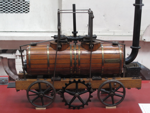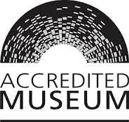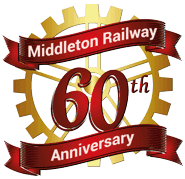General
Crane: Isles
Historic steam crane
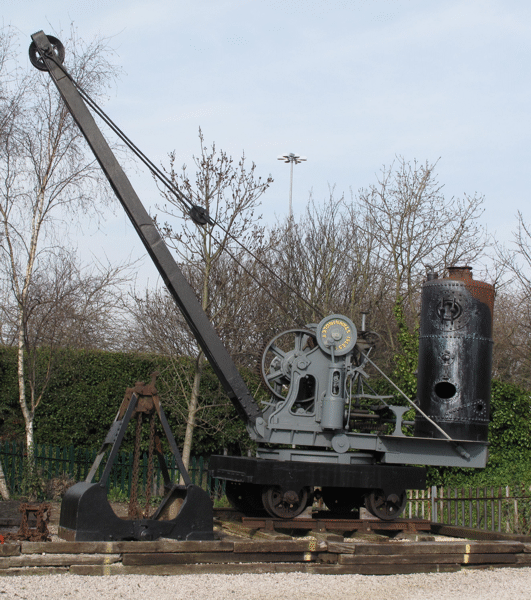
Historical note: Job Isles worked at Thomas Smith until 1864, but by 1869 he had set up his own firm in Farsley, and had then moved this to the Prospect Foundry in Stanningley by 1872. The firm ceased making cranes in 1928, and very few of their cranes have survived.
| Built | Probably in the late 1890s or early 1900s by Job Isles Ltd., at Stanningley near Leeds |
| Load capacity | An early catalogue lists it as a 5 ton design, but 2 tons would be a more realistic figure |
| Jib length | 20' (approx 6.1 metres) |
| Previously worked | Various local firms, finishing at Clayton Son & Co. Ltd |
| Entered collection | Donated by Clayton, Son & Co Ltd. in 1983, when their Dartmouth Yard closed |
| Current status | Displayed as a static exhibit |
More details of this vehicle are given in our stockbook.
Go on to Smith 10-ton crane.
Go back to Booth 2-ton crane.
More Information
Other pages provide more information about:
Crane: Booth 2-ton
Historic steam crane
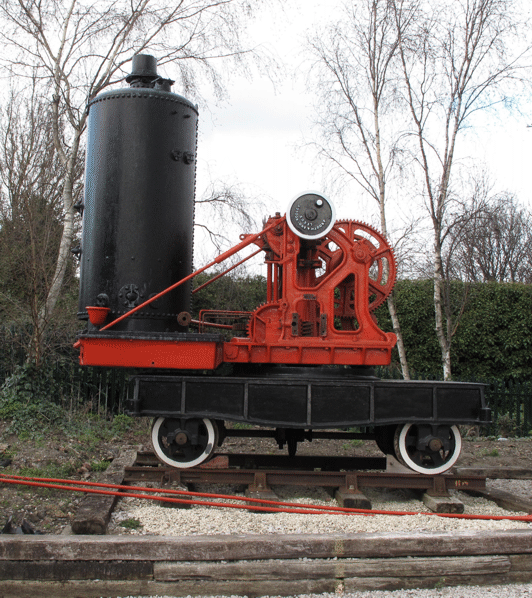
Historical note: This crane is believed to have been built for the Great Western Railway while this railway still had some broad gauge track (ie before 1892), as the crane has fittings that are intended for use on broad gauge rails as well as a set that are intended for standard gauge rails.
| Built | Probably early 1890s, by Joseph Booth & Bros, at Rodley, near Leeds |
| Load capacity | 2 tons |
| Jib length | 31' (approx 9.4 metres) |
| Previously worked | Probably on the GWR, before being sold for industrial use. It had been used by Clayton, Son & Co Ltd. prior to the early years of preservation of the MRT. |
| Entered collection | Donated by Clayton, Son & Co Ltd. in 1983, when their Dartmouth Yard closed |
| Current status | Displayed as a static exhibit, but requires the jib re-fitting |
More details of this vehicle are given in our stockbook.
Go on to Isles crane.
More Information
Other pages provide more information about:
Rolling Stock - Cranes
Ever since the preservation of the Middleton Railway, it has needed to use cranes for all kinds of lifting operations. In the early years of preservation two steam cranes were available for this, and these are still in the MRT's collection. Then an ex-Midland Railway hand crane was acquired, but since this had a wooden jib it was not long before it became illegal to use it for lifting operations, and so it was passed on to the Midland Railway Centre at Butterley for preservation as a museum piece.
In the late 1970s a 5-ton diesel crane, which had been built by Booth of Rodley, was purchased by a member and donated to the MRT. Over the next 25 years or so it proved invaluable, particularly for permanent way work, but eventually had to be taken out of use because it was no longer safe. By this time the MRT had acquired a 10-ton diesel crane, which had been built by Smith of Rodley, and this had become the main operational crane. By 2012, however, it was beginning to need an overhaul, and fortunately the MRT was able to acquire another 5-ton crane, also built by Smith of Rodley, to ensure that lifting operations could continue while this overhaul took place. This meant that the 5-ton Booth crane was no longer needed, and it has been dismantled to provide spares.
The MRT's collection of cranes therefore consists of two group. The first group is the old steam cranes, which are no longer operational, but are now historic items in their own right. They are as follows.
- Booth 2-ton crane; and
- Isles Crane.
The second group of cranes in the MRT's collection consists of the operational diesel cranes, and these are as follows.
The pages for these cranes give a brief overview of our collection, but for more information about it our stock book is available in the shop. Click here for more details of this.
Return to the page for our museum collection.
More Information
Pages about other categories of museum exhibits:
- Steam Locomotives;
- Diesel and Electric Locomotives;
- Coaches (and other passenger vehicles);
- Goods wagons;
Other pages provide more information about:
Hunslet Wagon Restoration
In June 2015 we ran an event to celebrate the 150th anniversary of the first locomotive to have been built by the Hunslet Engine Company Ltd. As part of our preparations for this, we restored the flatbed wagon that we had acquired from Hunslet's, starting in January 2015.
This restoration included the fitting of a through vacuum brake pipe, so that the wagon could be run as part of a passenger train. Originally, of course, the wagon had not had any vacuum brake fittings.
A page documenting this restoration formed part of the special web site that was created for that event. That site ceased to exist not long after the event, but we did not want to lose the record of this wagon restoration project, and so the material from it (including the logos that had been created specially for the event) has all been transferred to this page.
On the original site the pictures of the restoration work were laid out in rows of three, and appeared in that layout on any device. Here they have been re-arranged into rows of two, or a single column if you are viewing the page on a mobile phone, so as to give a better appearance.
 |
 |
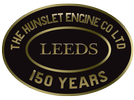 |
Below is the photo gallery of the restoration of our ex-Hunslet works flatbed which was converted from an earlier wagon in 1951. Parts of it were found to date from 1897 and 1903!
Progress for the end of February : chassis well underway, brake gear overhauled and a sneak peek at the final livery!
April 22nd : The chassis lifted off its wheels to enable better access.
April 25th - May 10th : The wheels have been needled gunned down and painted up in red oxide. Also the brake gear painted up to black gloss.
May 24th - 31st : The frames were painted from red oxide up to black gloss/Brunswick green, a through pipe was fitted and brake hangers were sourced, as well as dolly hangers. The wooden planks were cut to size and offered up.
June 22nd : The wagon is now almost complete with the decking in place, brake gear finished and vacuum system complete. It is all looking very smart and the remaining jobs include axlebox lubrication (the original system used animal fat) and signwriting.
June 29th : This weekend some finishing touches were made to the paintwork, including picking out the brake handles with white ends. The signwriting has also begun as the picture below shows. This really is an exciting final step on the road to restoration.
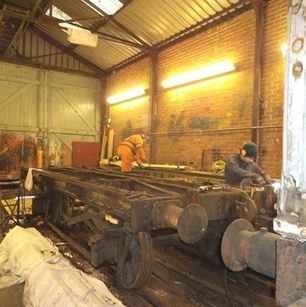
The wagon chassis in the workshop
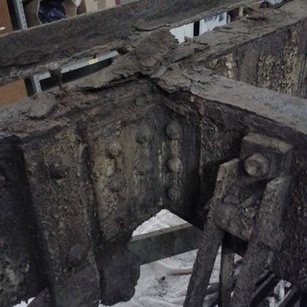
A close-up of a chassis angle, before cleaning
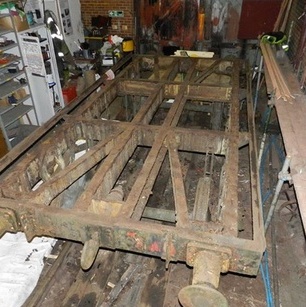
The chassis before painting, from above
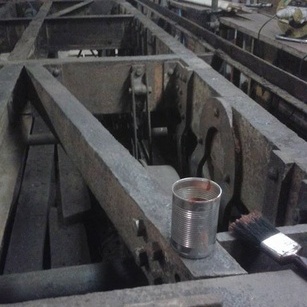
An end view of the chassis, after needle-gunning
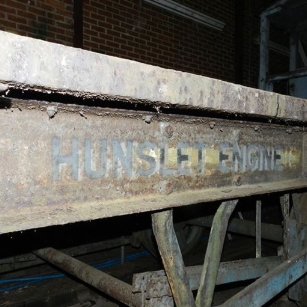
Original lettering on the solebar, revealed by the cleaning
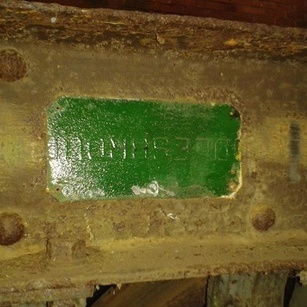
A patch of original Hunslet green paint on the solebar, revealed by removal of a plate
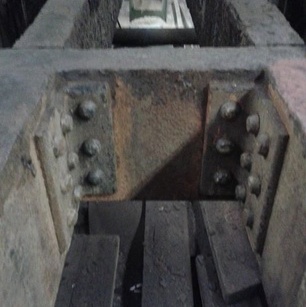
A close-up of the chassis angles, after needle-gunning
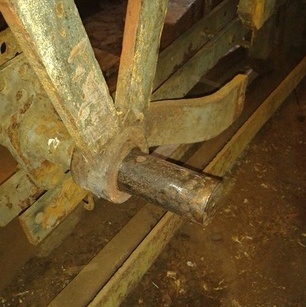
A close-up of a brake-lever pin, before cleaning
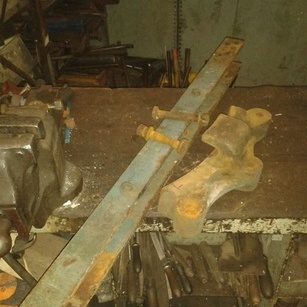
Brakegear components on the workbench
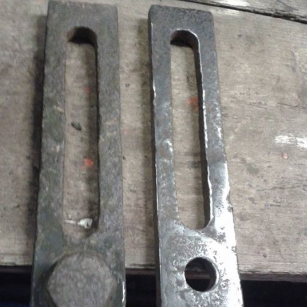
Brakegear slotted levers on the workbench
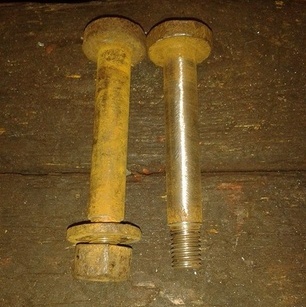
Two bolts, one cleaned and the other waiting to be cleaned
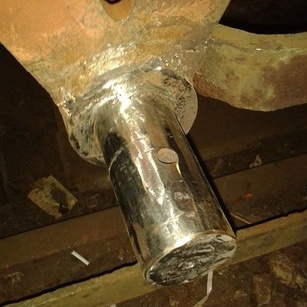
A close-up of a brake-lever pin, after cleaning
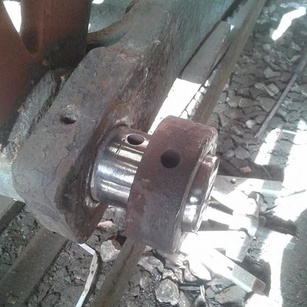
Close-up of brake lever pin collar
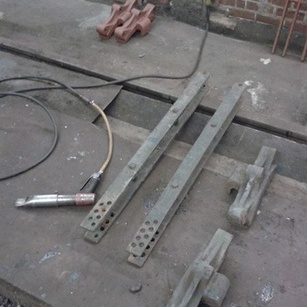
Brakegear components after needle-gunning
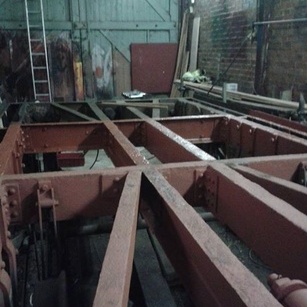
A closer view of the wagon chassis
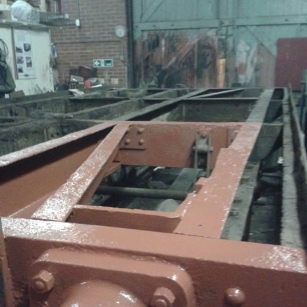
An end view of the chassis, partly primed
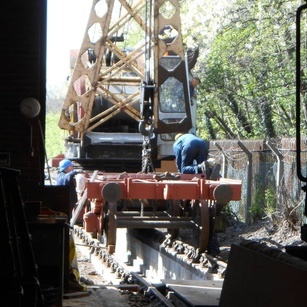
Preparing to llift the chassis off its wheels
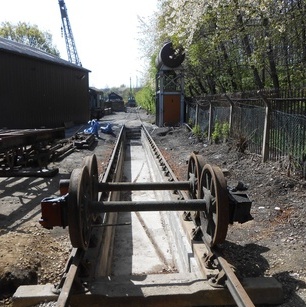
Wheelsets over the pit, before painting
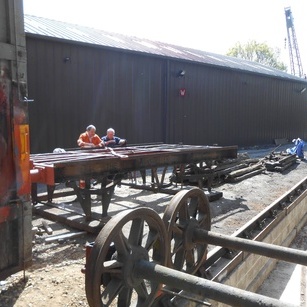
Wheelsets and chassis with the Engine House behind
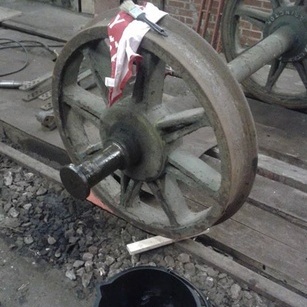
A close-up of one wheel, before painting
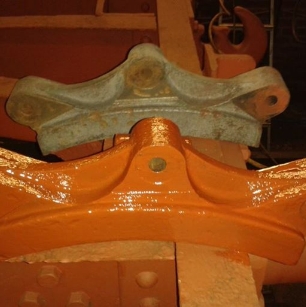
A brake shoe in primer
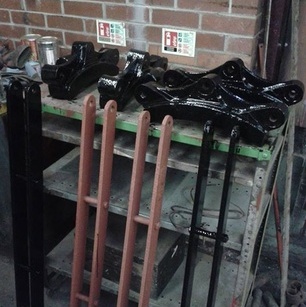
Brake levers in primer, and brake shoes in black
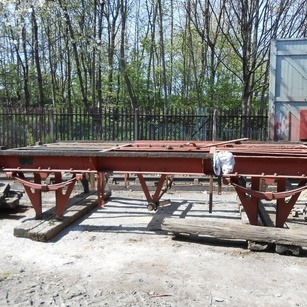
The chassis outside, in primer
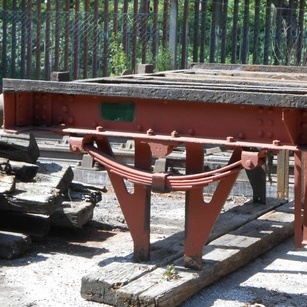
A close-up of one set of the W irons
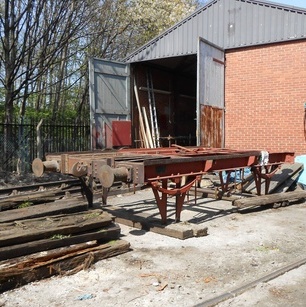
The chassis outside the workshop
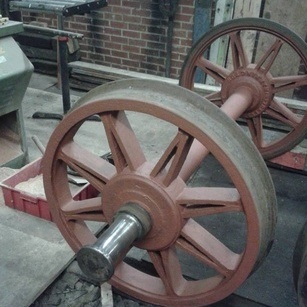
One wheelset in primer
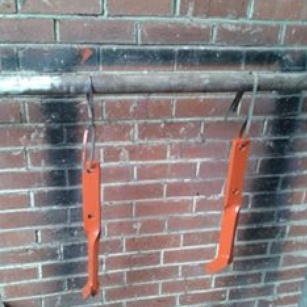
The two vacuum pipe dollies drying
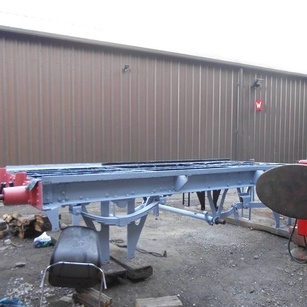
The chassis outside, in light grey undercoat
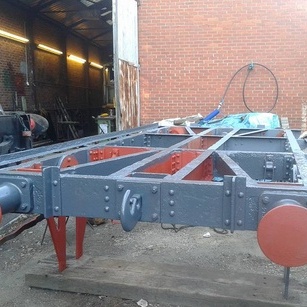
An end view of the chassis, mostly in grey undercoat
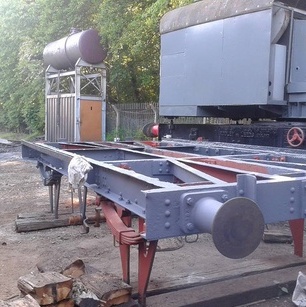
The chassis outside, with the water tower behind
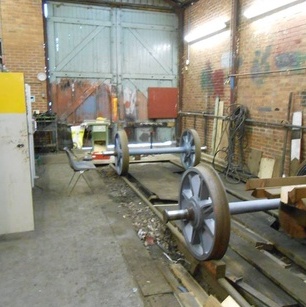
The wheelsets in the workshop during painting
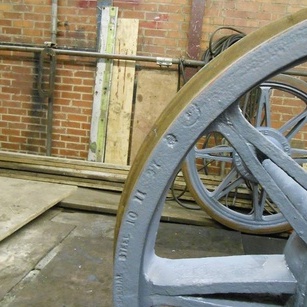
A wheel rim, showing the inscription "Millom Steel 10 11 97"
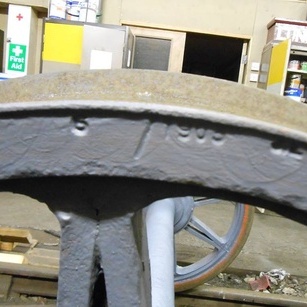
A close-up of a wheelrim, showing the date (1905)
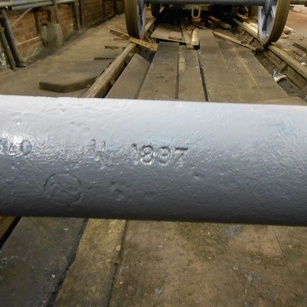
An axle showing the forging date (1897)
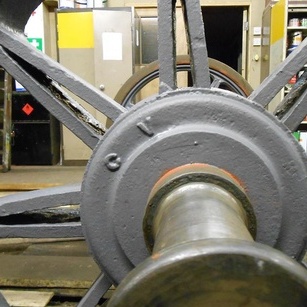
A wheelset journal, with the boss in primer
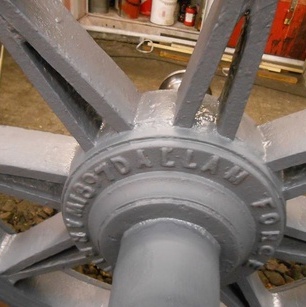
The inside of a wheel boss, showing the inscription "1897 Dallam Forge"
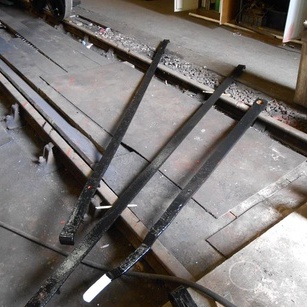
Three painted brake levers
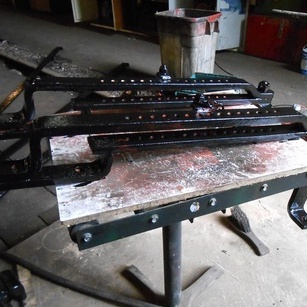
Parts of the brake gear after painting
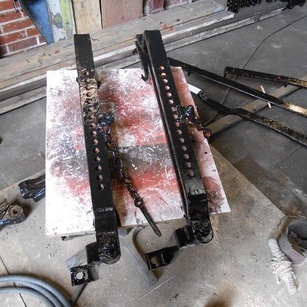
An end view of parts of the brake gear after painting
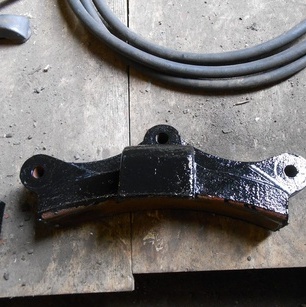
One brake shoe, in black
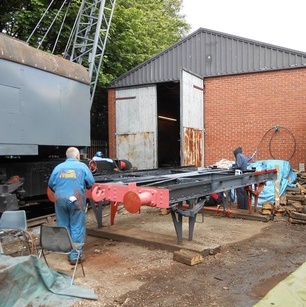
The chassis outside, with the crane alongside it
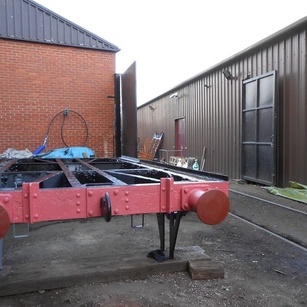
An end view of the chassis, with the buffer beam in red undercoat
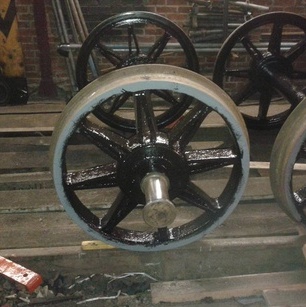
A wheelset, partly painted
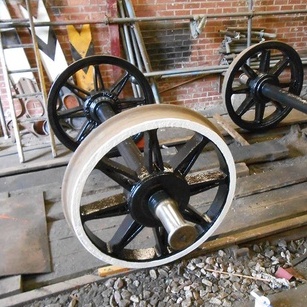
The painted wheelsets in the workshop
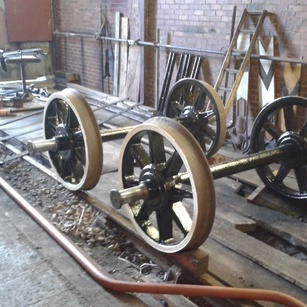
The wheelsets in the workshop, with the vacuum brake pipe
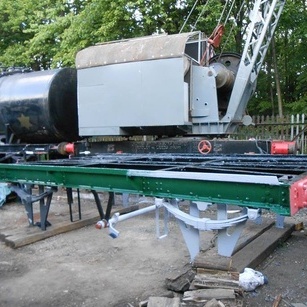
The chassis outside, partly in green top coat
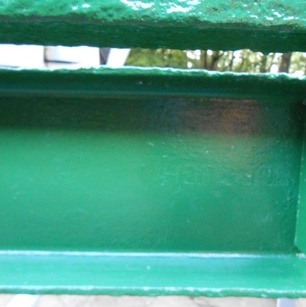
A close-up of a chassis solebar in green top coat
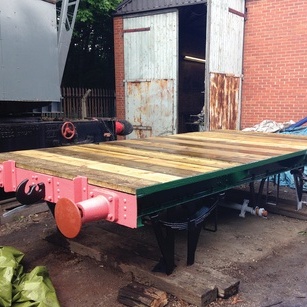
The chassis with the timber decking almost complete
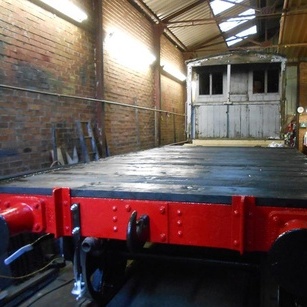
The finished wagon in the workshop
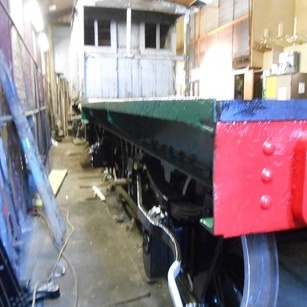
A chassis solebar and the end of a bufferbeam, waiting for the last bits of brake gear to be fitted
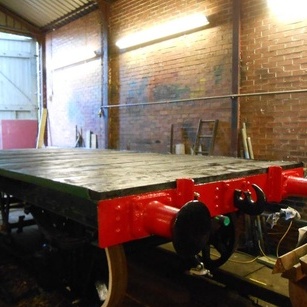
One end of the finished wagon in the workshop
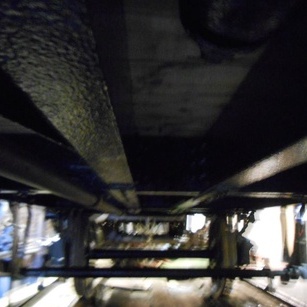
The underside of the chassis
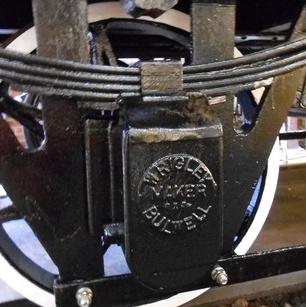
A painted axlebox, showing the inscription "Wrigley Maker Bulwell"
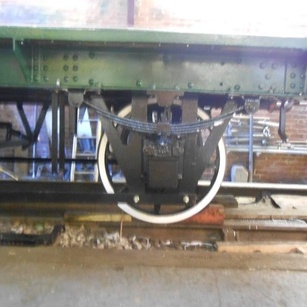
A side view of the wagon
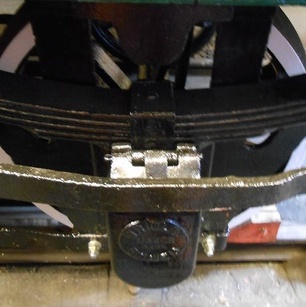
A spring and axlebox
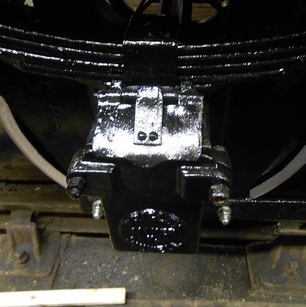
A close-up of an axlebox
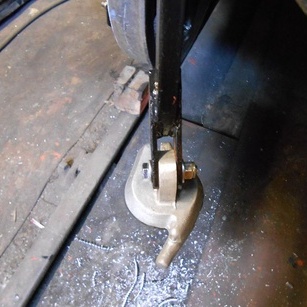
A vacuum brake pipe dolly
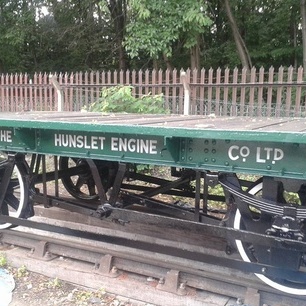
The finished lettering on the wagon
Overhaul of No. 6 Part 1
As explained in the main page for this project, the overhaul of No. 6 started in 2001, and by 2005 had reached a stage where it was appropriate to start work on the boiler, but this then got overtaken by the project to completely remodel the Moor Road site and construct the Engine House building. By 2014, when work on the locomotive resumed, it became apparent that major boiler repairs would be needed, and once we had done what work we could on the boiler, then an appeal was launched to fund the rest of these repairs.
At this time much of our engineering work was focused on the project to overhaul "Brookes No. 1", but once this locomotive was returned to steam successfully in August 2017 then we could start to look again at what needed to be done to the chassis of No. 6. By this time we had acquired a pair of proper boiler stands, and the boiler of No. 6 was the first to be put on them, as shown in the picture below.
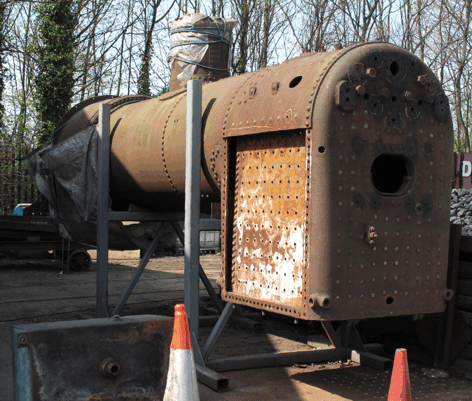
Assessing the work needed for the chassis involved a lot of careful measurement, and one of the main conclusions of this was that the crankpins on the wheels were not as round as they should be. Putting this right involved a little bit of work with a grinder, a lot more work with files, and finally finishing off each pin with emery cloth.
Once we had the pins round, then it was possible to fit the bearings to them, which involved machining out the gunmetal a bit to allow the bearing surfaces to be coated with white metal, and then very careful machining of each bearing to ensure that it fitted properly to the corresponding crank pin. Then the side rods and connecting rods could be painted, and the picture below shows the two painted connecting rods on the ground alongside the chassis, and the left hand side rod up on the footplate.
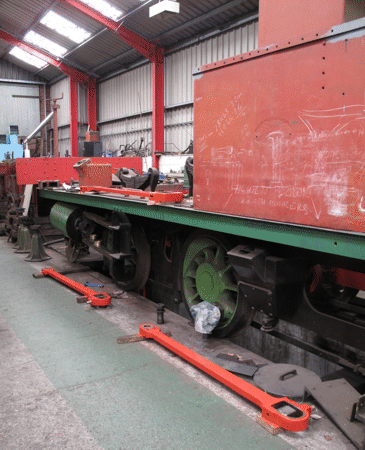
Another piece of work that had been identified by all the measurements that had been made was that the piston rings were sufficiently worn to need some attention. Since we had some material for making new piston rings left over from the overhaul of "Brookes No. 1", we decided to use this and make new piston rings. To go with these we also decided to replace the glands on the rear cylinder covers, which seal round the piston rods. The picture below shows one of the cylinder covers waiting to be refitted to the cylinder.
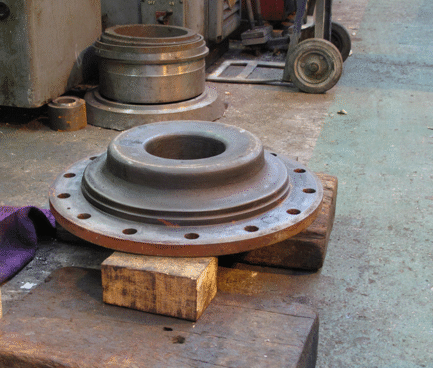
The other piece of work that had been identified by the measurements was the need to fit the crossheads to the slidebars. The slidebars themselves needed very little attention, and so the first step was to adjust the positions of the bottom slidebars on each side, to ensure that they were parallel to the centre lines of the cylinders. This was done by fitting shims at each end of each slidebar, and the picture below shows the left-hand side of the chassis with the bottom slidebars in their correct positions. At this point the front cylinder covers had not yet been fitted, to allow the centre lines of the cylinders to be measured accurately.
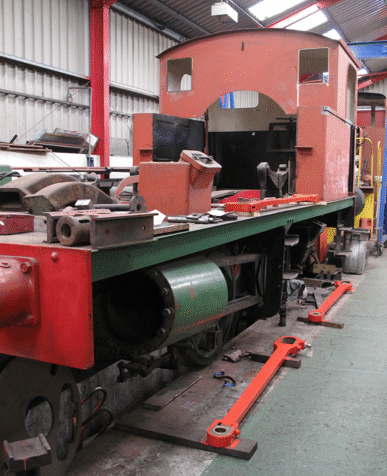
With the bottom slidebars in their correct positions, the next step was to fit the crossheads. These needed to have their centre lines at exactly the right height to match the centre lines of the cylinders, and this involved overhauling the slippers that are mounted in the crossheads, and that slide on the slide bars. As with the bearings, this was done by coating the slippers with white metal and then machining them to fit, and the picture below shows one of our volunteers preparing a slipper for this.
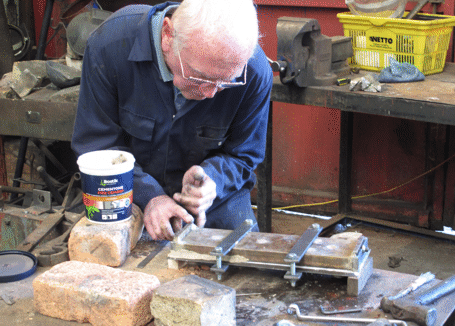
Once the slipper was ready, then a suitable quantity of white metal had to be melted in a ladle, as shown in the picture below.
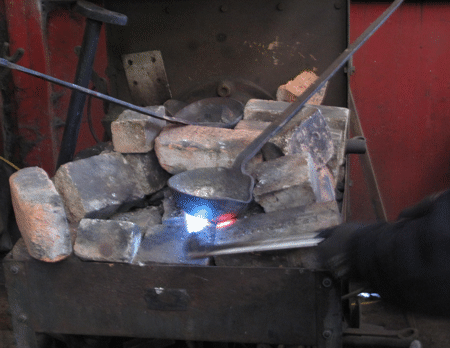
Then another of our volunteers could pour the molten white metal into the mould that held the slipper, so as to coat the slipper with the white metal, as shown in the picture below.
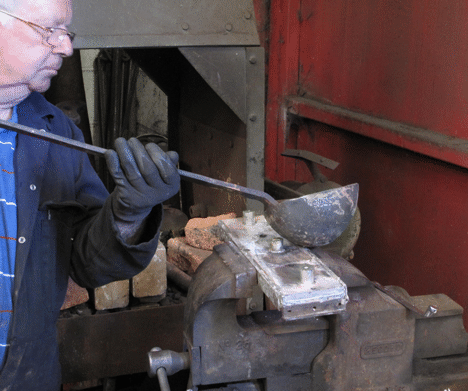
Once everything had cooled down, then the outside of the slipper could be machined to fit exactly into the crosshead, and the picture below shows one of our volunteers doing this on the milling machine.

Then the slipper could be mounted in the crosshead, and the surfaces that slide on the slide bars could be machined to fit the slide bars. This too was done on the milling machine, as shown in the picture below.
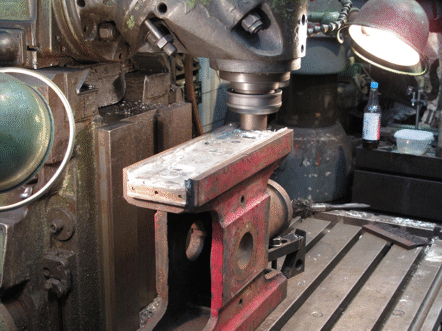
An essential part of getting a good fit between the slipper and the slide bars is careful measurement, and the picture below shows the width of the gap between the sides of the slipper being checked with a micrometer.
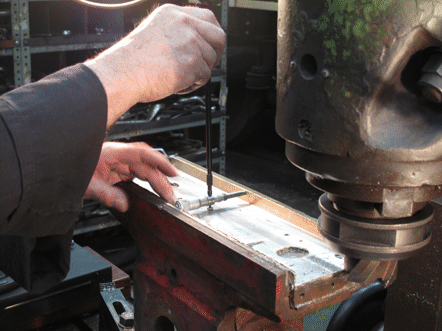
Once the crosshead slippers had been machined to the correct dimensions, then the crosshead could be positioned in the slide bars, and the height of the top slide bar adjusted by shimming it to give exactly the right clearance between the bottom and top slide bars. Another of our volunteers is shown in the picture below, measuring the thicknesses of the shims that are needed, using a set of reference shims from the yellow case on the floor.
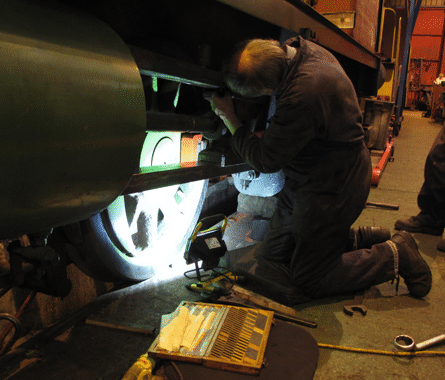
With both slide bars fitted to give the correct clearances for the crosshead, then the side rods and connecting rods could be fitted, as shown in the picture below of the left-hand side of the chassis.
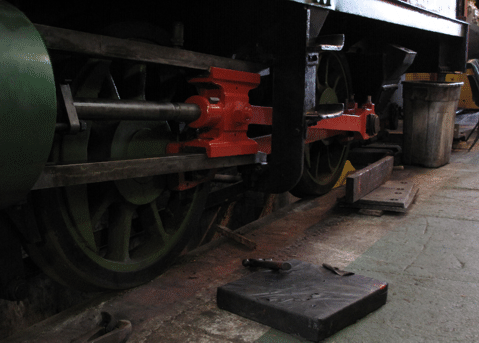
Then, of course, the whole process had to be repeated for the right-hand side of the chassis. The picture below shows one of our volunteers fitting the crosshead onto the piston rod, so that then the cotter pin can be driven into place to hold it tight.
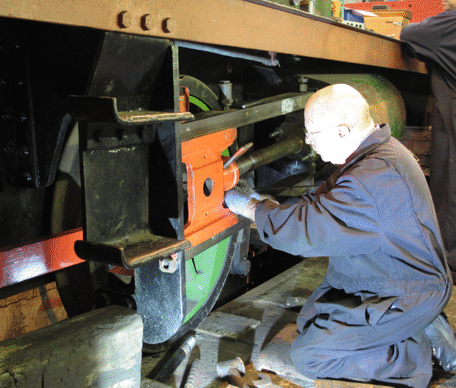
Once everything fitted correctly, with the slide bars, crossheads, piston rods, side rods and connecting rods all in place, then attention needed to be turned to the sanding gear. The sand boxes were found to be fairly well blocked with old sand, and a lot of time had to be spent cleaning this out. Then the sand boxes could be painted and fitted to the chassis, and the picture below shows the rear right-hand sand box in place.
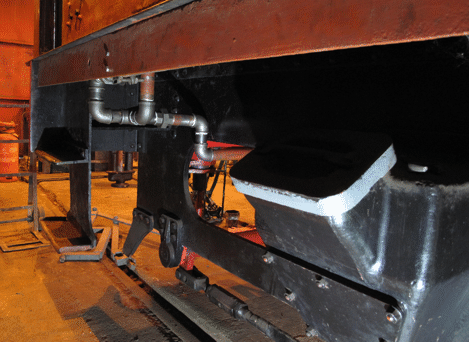
While the sanding gear was being worked on, work also started on fitting the locomotive for vacuum braking, which it had not previously had. The picture above shows some of the vacuum brake piping under the cab, and the picture below shows the front buffer beam with the vacuum brake pipe and hose in place, and behind it the dolly for the brake hose.
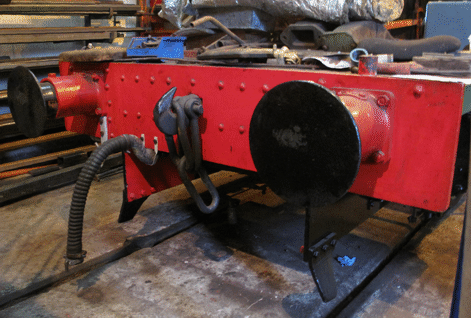
Because the locomotive never had vacuum braking previously, fitting the pipework for it has not been easy, as we wanted to try to keep this out of sight as far as possible. Consequently, a lot of the piping has involved short lengths fitted together with elbows that are screwed onto the ends of the pieces of pipe. Our screw-cutting machine has proved very useful for making the screw threads on the ends of the lengths of pipe, and the picture below shows one of our volunteers operating it to cut the thread on the end of a piece of pipe.
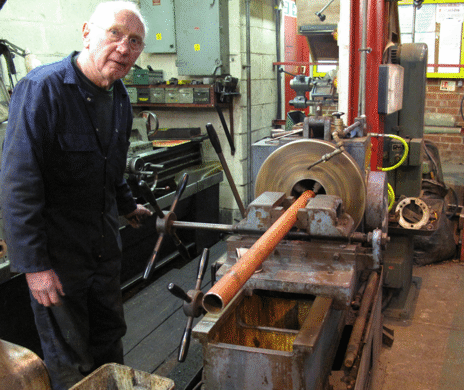
Meanwhile, discussions about the boiler repairs had been going on with various contractors, which had indicated that fortunately the cost of these was likely to be closer to £40,000 than the £60,000 for which we had originally been budgeting. This, together with the prospect that funding which could cover this figure would become available, encouraged us to decide in January 2019 to place a contract with Northern Steam Engineering Ltd. for the boiler work to be done. So, the boiler was lifted off the stands, and the picture below shows it waiting to be transported to their works in Stockton-on-Tees.
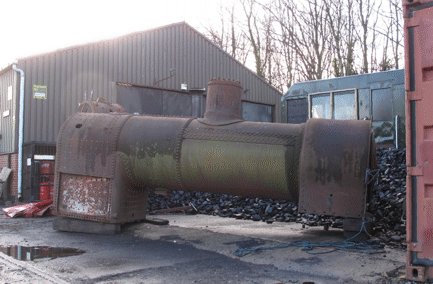
The departure of the boiler marked a natural break in the overhaul work, and to reflect this the story of the project is continued on a separate page.
Go to the page for part 2 of the overhaul.
Go back to the main page for this project.
Go to the page "Help Raise Steam in No. 6", which describes the appeal for funds that we needed to set up to help finish this project (although this appeal is now closed).
More Information
Pages about other projects:
- Last Coals to Leeds;
- Project Phoenix;
- Building a Running Shed;
- Overhauling "Brookes No. 1";
- Conserving "Picton".
Other pages provide more information about:
Subcategories
Projects
Projects and appeals.
Volunteering
For pages related to volunteering and membership

